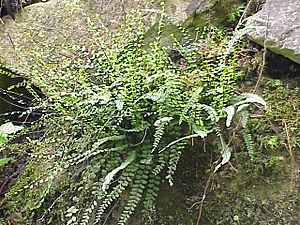Maidenhair spleenwort facts for kids
Quick facts for kids Maidenhair spleenwort |
|
|---|---|
 |
|
| Asplenium trichomanes subsp. quadrivalens | |
| Conservation status | |
| Scientific classification | |
| Genus: |
Asplenium
|
| Species: |
trichomanes
|
The Maidenhair Spleenwort (scientific name: Asplenium trichomanes) is a small fern. It belongs to a group of ferns called Asplenium, also known as spleenworts. This fern is very common and can be found almost everywhere in the world. It grows in many different rocky places. There are also several types, or subspecies, of this fern.
The name trichomanes comes from a Greek word that means "fern."
Contents
What It Looks Like
The Maidenhair Spleenwort usually grows about 10 to 30 centimeters (4 to 12 inches) tall. It forms clumps from a short, scaly underground stem called a rhizome. This rhizome has dark scales.
The leaves, called fronds, stay green all year. They are long and thin, getting narrower towards the end. Each frond is divided into many small, roundish parts called pinnae. These pinnae are usually yellow-green to dark-green. The main stem of the frond, called the stipe, and the central stalk, called the rachis, are dark along their whole length. Fronds can grow up to 40 cm (16 inches) long, but they are usually 8–20 cm (3–8 inches).
On the underside of the fertile pinnae, you can find small, oval-shaped structures called sori. These sori are where the fern's spores (like seeds) are made. Each pinna usually has 4 to 8 sori, and each sorus is about 1 to 3.5 millimeters long.
Where It Lives and Grows
This fern is found in many parts of the world. It lives in temperate (mild climate) and subarctic (cold climate) areas. You can also find it in mountains in tropical regions.
Its range includes most of Europe and much of Asia, reaching as far south as Turkey, Iran, and the Himalayas. There's even a group of them in Yemen. It grows in northern, southern, and parts of eastern Africa. You can also find it in eastern Indonesia, southeastern Australia, Tasmania, New Zealand, and Hawaii. In the Americas, it lives in North America, Central America, Cuba, and the northern and western parts of South America, like Chile.
Even though it's found in many places, it can be rare in some areas. This is because it needs specific rocky places to grow.
The Maidenhair Spleenwort loves rocky spots. You can find it on cliffs, rocky slopes (called scree slopes), old walls, and even in areas where mines used to be. The type of rock it grows on can depend on the specific subspecies. It can grow from sea level up to 3000 meters (about 9,800 feet) high in North America. In the British Isles, it grows up to 870 meters (about 2,800 feet).
In the US state of Minnesota, A. trichomanes is listed as a threatened species. This means it's rare and needs protection there. It grows on ledges and in cracks on moist, east-facing cliffs.
Growing Maidenhair Spleenwort
People like to grow the Maidenhair Spleenwort in gardens because it's a tough plant. It can survive in cold temperatures, even down to about -20°C (-4°F). Its leaves stay green all year, which is nice. It's also good at growing in cracks in stone walls. This fern prefers to grow in places that are fully or partly shaded from the sun.
Because it's such a good garden plant, it has received the Royal Horticultural Society’s Award of Garden Merit. This award means it's an excellent plant for gardeners.
Different Types of Maidenhair Spleenwort
The Maidenhair Spleenwort has different types based on its chromosomes. These types are called diploid, tetraploid, and hexaploid. Think of them as different "versions" of the fern. Scientists have suggested that these different versions should be seen as their own species. There's also a triploid type, which is a mix of the diploid and tetraploid types and cannot reproduce on its own.
Within these types, several subspecies are recognized:
- Asplenium trichomanes subsp. trichomanes: This type prefers rocks that are acidic, like sandstone, basalt, and granite. In Europe and North America, it's often found in mountains and is more common in northern areas. It's a delicate plant with a thin stipe and rachis, and fewer pinnae. This is a diploid type.
- Asplenium trichomanes subsp. quadrivalens: This type prefers rocks that contain calcium carbonate, like limestone and dolomite. It often grows on the mortar in walls. It's more common than A. t. subsp. trichomanes in many parts of Europe. Compared to the trichomanes subspecies, it's sturdier and has more pinnae. The fronds of this type tend to grow very close to the rock. This is a tetraploid type.
- Asplenium trichomanes subsp. pachyrachis (also known as Asplenium csikii): This one is mostly found on limestone rocks and walls. It's small and delicate, grows close to the rock, and has a stiff, easily broken stipe and rachis. This is a tetraploid type.
- Asplenium trichomanes subsp. coriaceifolium (also known as Asplenium azomanes): Found in places like Majorca, Spain, and Morocco. This is a tetraploid type.
- Asplenium trichomanes subsp. maderense: Found in Madeira and the Azores. This is a hexaploid type. Hexaploids are also found in Australia and New Zealand.
Images for kids
See also
 In Spanish: Culantrillo menudo para niños
In Spanish: Culantrillo menudo para niños



